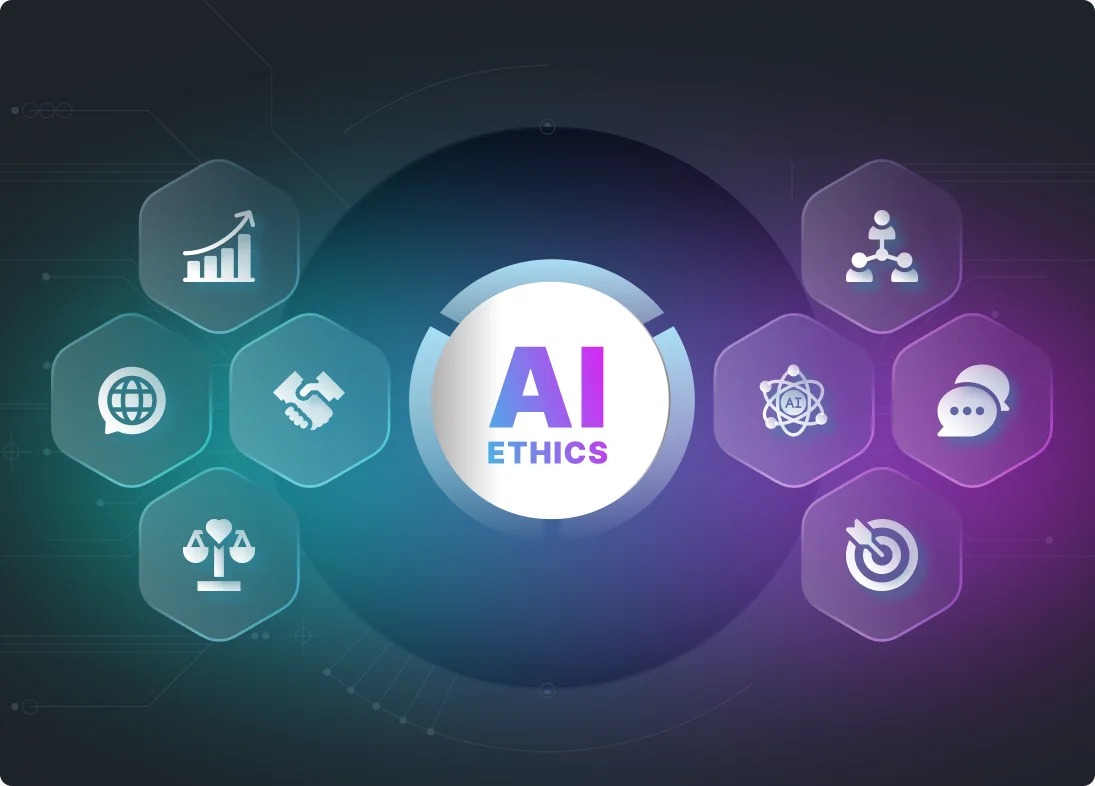
Ethics of AI companions / emotional bots: what is acceptable, what isn’t.
As AI companions and emotional bots become increasingly sophisticated, they blur the line between genuine human connection and artificial simulation, offering comfort, conversation, and companionship. While these systems can alleviate loneliness and support mental health, they also raise profound ethical concerns about deception, emotional manipulation, dependency, and the commercialization of affection, demanding clear guidelines for responsible and transparent use.
✨ Raghav Jain

Introduction
Artificial Intelligence (AI) has evolved far beyond data analytics and automation. The emergence of AI companions and emotional bots represents a profound shift in how humans interact with technology. From chatbots that simulate empathy to virtual partners that claim to "understand" emotions, these technologies are redefining relationships, loneliness, and even mental health. However, as these systems become more advanced, the ethical implications grow more complex. Can a machine truly “care”? Should emotional manipulation for comfort be allowed? How much intimacy between humans and AI is acceptable — and what crosses the line?
AI companions like Replika, Character.AI, and ChatGPT-based emotional bots are already being used by millions worldwide. They offer solace, conversation, motivation, and even romantic engagement. For some, these bots serve as therapy substitutes; for others, they become emotional anchors. Yet, the illusion of empathy and affection created by algorithms raises serious moral and social questions. Is it ethical to allow machines to mimic human emotion so convincingly that users develop genuine attachment?
This article delves into these questions, exploring what’s acceptable, what’s not, and why the ethics of AI companionship must evolve as fast as the technology itself.
The Rise of Emotional AI: Understanding the Landscape (Approx. 1000 Words)
The past decade has witnessed a revolution in AI capabilities, particularly in Natural Language Processing (NLP) and affective computing — technologies that allow machines to interpret and simulate human emotions. Emotional bots can now recognize tone, sentiment, and behavioral cues to craft personalized emotional responses. These bots are no longer limited to simple assistants like Siri or Alexa; they can act as friends, therapists, mentors, or romantic partners.
1. Why People Turn to AI Companions
Loneliness is one of the most pervasive issues of modern society. Studies show that prolonged loneliness can have effects comparable to smoking or obesity on health. For many, AI companions fill emotional voids — offering nonjudgmental, 24/7 conversation and a sense of connection. Elderly users find comfort in friendly AI chatbots, while young people struggling with anxiety or depression use emotional bots as safe spaces for self-expression.
AI companions also serve educational and therapeutic functions. Some bots are designed to teach social skills to autistic individuals, while others help users practice languages or manage mental health. The attraction lies in the safety and predictability of these interactions — AI doesn’t argue, betray, or abandon.
2. The Illusion of Empathy
The fundamental ethical issue lies in the illusion itself. Emotional bots don’t actually feel emotions — they are programmed to simulate them. Their apparent understanding and compassion are statistical responses generated from massive datasets of human communication. When users perceive empathy from these systems, they’re experiencing emotional mirroring, not genuine understanding.
This raises a moral dilemma: is it ethical to design AI to imitate care and love when these feelings are algorithmic constructs? If users become emotionally dependent on illusions, does that constitute emotional manipulation?
3. The Commercialization of Emotion
AI companionship is increasingly commercialized. Many emotional bots operate on freemium models — basic companionship is free, but deeper emotional or romantic interactions require payment. This monetization of emotional intimacy risks exploiting loneliness. Users, particularly the vulnerable, may spend money not for utility but for the illusion of affection.
Moreover, corporations own and control these bots, meaning that every interaction can be monitored, analyzed, and monetized. Users often share deeply personal information with emotional bots, unaware of how their data is being used. The intersection of emotional manipulation and data exploitation is where ethical concerns peak.
4. Relationship Redefinition
Another key question: what does AI companionship do to human relationships? As bots become more sophisticated, people may prefer AI partners to human ones. Machines are consistent, attentive, and programmed to please — qualities that humans struggle to match. This could lead to emotional isolation, as people withdraw from real social interactions, preferring synthetic comfort.
The Japanese phenomenon of “digital love” — where people form relationships with virtual characters — is already showing how emotional AI blurs the boundary between reality and simulation. The long-term social effects could include declining empathy, difficulty forming real relationships, and even shifts in moral frameworks around intimacy and consent.
5. Emotional AI in Therapy and Care
On the other hand, not all emotional AI applications are problematic. Therapeutic bots like Woebot or Wysa use cognitive behavioral therapy (CBT) techniques to help users manage anxiety and depression. When used transparently — as tools, not replacements for human care — emotional bots can significantly enhance accessibility to mental health support.
In elderly care, AI companions can reduce loneliness, remind patients to take medication, or detect signs of distress. However, ethical use depends on clear boundaries: users must know they’re interacting with AI, and systems must be designed to support, not deceive.
Ethical Boundaries: What Is Acceptable and What Isn’t (Approx. 1000 Words)
As emotional AI becomes more embedded in society, ethical guidelines must determine what’s permissible and what isn’t. The key lies in transparency, consent, and human dignity.
Acceptable Practices:
- Transparency and Disclosure
- Users must always know when they’re interacting with an AI. Concealing an AI’s identity to manipulate emotions is unethical. Transparency ensures informed consent.
- Purpose-Bound Use
- Emotional AI can ethically assist in therapy, companionship for elderly care, or mental health support — provided users understand its limits. It should supplement human connection, not replace it.
- Privacy Protection
- Ethical emotional bots must strictly safeguard user data. Emotional conversations often involve highly sensitive information, and misuse of this data is a severe ethical violation.
- Non-Exploitative Design
- AI companions should not employ addictive engagement mechanics or emotional dependency to increase profits. Systems must be designed to promote emotional well-being rather than financial gain.
- User Empowerment
- Users should have full control over their data, emotional settings, and the ability to end the relationship easily. Ethical AI should respect autonomy and personal boundaries.
Unacceptable Practices:
- Emotional Manipulation for Profit
- Any system that intentionally deepens user attachment to sell premium features, gifts, or upgrades crosses a moral line.
- Concealed Identity
- Bots posing as humans or hiding their artificial nature constitute deception. Relationships built on deceit — even virtual ones — undermine ethical trust.
- Data Exploitation
- Using emotionally charged conversations to collect behavioral data for marketing or manipulation is unethical and potentially dangerous.
- Encouraging Dependency
- Systems that promote emotional dependency can harm mental health, leading to isolation or addiction to artificial comfort.
- Blurring Romantic and Sexual Boundaries
- AI systems simulating romantic or sexual relationships without ethical frameworks risk distorting users’ perceptions of consent and intimacy.
Philosophical Perspectives:
From a utilitarian view, emotional bots are ethical if they increase happiness without harm. From a deontological perspective, deception — even for comfort — is inherently wrong. Meanwhile, virtue ethics focuses on character: does AI companionship promote or erode human virtues like empathy, authenticity, and courage?
Most ethicists agree that AI should not replace genuine human relationships, but rather complement them by offering temporary or therapeutic support. Emotional authenticity remains a human domain; machines, however advanced, lack consciousness and moral responsibility.
Regulation and the Road Ahead
Regulation is still catching up. Countries like the EU are working on AI Act frameworks, which classify emotional manipulation as “high risk.” Developers may soon be required to disclose emotional simulation mechanisms and adhere to consent protocols.
In the future, ethical design principles — like emotional transparency, non-exploitation, and consent-based interaction — will likely become mandatory. The challenge is balancing innovation with moral restraint, ensuring AI companionship enhances life without eroding the essence of human connection.
The rise of AI companions and emotional bots marks one of the most profound and controversial developments in modern technology, transforming how humans perceive relationships, empathy, and companionship in the digital age. These advanced systems, powered by natural language processing and affective computing, are designed to simulate emotional understanding, creating the illusion of genuine care, attention, and affection. Emotional bots like Replika, Character.AI, and others have attracted millions of users globally who seek solace, understanding, or simply conversation without judgment or rejection. They offer the promise of constant companionship, available 24/7, tailored to individual moods, desires, and emotional needs. Yet, beneath the charm of these intelligent systems lies an unsettling ethical dilemma — can a machine that does not feel emotions ethically simulate love, empathy, or care? The fundamental issue lies in the illusion of emotional reciprocity; these bots do not truly "understand" users but rather generate responses based on algorithms trained on massive datasets of human communication. When users perceive understanding or affection from an AI, they are interacting not with a conscious being but with an intricate reflection of their own emotions, mirrored back through code. This simulation becomes ethically problematic when users begin to form deep emotional attachments, mistaking artificial warmth for genuine empathy. Loneliness, social anxiety, and emotional vulnerability make people particularly susceptible to such illusions, creating a cycle where emotional reliance on technology grows while real human connection diminishes. This emotional dependence is not merely psychological but also commercial; companies behind these bots often employ monetization strategies that exploit emotional attachment. Many platforms offer premium features that deepen “relationships” — romantic interactions, personalized emotional responses, or simulated intimacy — for a price. This commodification of affection crosses an ethical line, as it transforms emotional fulfillment into a transaction. The situation becomes even more concerning when users, often unaware of the commercial intent, begin sharing deeply personal details, unaware that their conversations may be stored, analyzed, or used for data-driven marketing. Thus, emotional bots present a dual-edged sword: while they can alleviate loneliness and provide comfort, they also risk manipulating users’ emotions for profit. The ethical question deepens when considering their impact on social and moral development. As AI companions become more engaging, people might start preferring them over human relationships, leading to emotional isolation. Machines are consistent, agreeable, and incapable of betrayal — traits that make them appealing but ultimately hollow substitutes for human complexity. Overreliance on emotional AI could dull genuine empathy, as users become accustomed to one-sided interactions that always validate their perspective. Furthermore, these systems raise concerns about identity and authenticity — what does it mean to “love” or “be loved” by something that lacks consciousness? Can emotional satisfaction derived from a simulation be considered genuine? Philosophers and ethicists argue that while emotional AI may comfort individuals, it could simultaneously erode the essence of human empathy, compassion, and moral responsibility. However, AI companionship isn’t inherently unethical when used transparently and responsibly. In therapeutic contexts, AI-driven chatbots like Woebot and Wysa demonstrate how emotional simulation can serve positive purposes, using cognitive behavioral therapy techniques to support users struggling with anxiety or depression. In elderly care, AI companions provide company to those isolated or suffering from memory disorders, reminding them to take medication or offering friendly interaction. The ethical acceptability in these cases depends on transparency — users must always know they’re interacting with an AI, not a human, and must retain autonomy over data and interaction boundaries. Ethical AI design should be guided by principles of transparency, non-exploitation, data privacy, and human dignity. Systems must clearly disclose their artificial nature, prevent emotional manipulation, and protect user information with the same rigor as medical data. It is ethically unacceptable for AI systems to pretend to be human, exploit emotional dependence for profit, or blur the lines of romantic or sexual interaction without explicit user consent and understanding. Additionally, emotional bots must be regulated to ensure they don’t encourage addiction-like attachment. For instance, using reward mechanics or emotionally charged messaging to keep users engaged constitutes emotional exploitation. Governments and institutions must enforce guidelines similar to Europe’s proposed AI Act, which identifies emotional manipulation as a “high-risk” category requiring transparency and ethical oversight. From a moral philosophy perspective, the debate on emotional AI sits at the intersection of utilitarianism, deontology, and virtue ethics. Utilitarian thinkers argue that AI companions are ethical if they maximize happiness without causing harm, while deontologists assert that deception — even benevolent — is inherently wrong. Virtue ethicists, on the other hand, question whether reliance on synthetic empathy promotes or diminishes human virtues like honesty, authenticity, and emotional resilience. The consensus among ethicists is that AI companions should enhance, not replace, human relationships. They should support mental health, learning, and well-being but never deceive users into believing in false emotions or consciousness. The ultimate ethical boundary lies in recognizing that machines, however advanced, do not possess moral agency or emotional depth. They can mimic care but cannot feel it. As technology progresses, society must develop moral literacy to understand that emotional AI can comfort but not connect, simulate empathy but not sincerity. The danger is not that machines will become more human, but that humans will start expecting less from each other — settling for emotional simulations instead of genuine relationships. To prevent this dystopian drift, emotional AI must be developed with human-centered ethics, ensuring transparency, accountability, and emotional honesty. In conclusion, AI companions and emotional bots represent both the promise and peril of technological empathy. Their capacity to heal loneliness and enhance well-being is real, but so is their potential to manipulate, exploit, and isolate. What is acceptable, therefore, is emotional assistance that respects human autonomy and dignity; what isn’t is deception, exploitation, or replacement of authentic human connection. The future of emotional AI depends not only on how we design these systems but also on how we, as a society, define and protect the boundaries of human emotion itself.
The advent of AI companions and emotional bots represents one of the most significant and complex technological developments of the 21st century, reshaping the way humans interact with machines and, more importantly, challenging the very foundations of emotional and ethical boundaries in human relationships, because these AI systems, powered by sophisticated natural language processing, affective computing, and deep learning algorithms, are designed not merely to provide information or automate tasks but to simulate emotional awareness, empathy, and companionship in ways that can be astonishingly human-like, offering a seemingly attentive ear, responsive conversation, and personalized engagement that can adapt dynamically to the moods, preferences, and psychological needs of individual users, creating interactions that feel intimate, supportive, and psychologically validating, which explains why millions around the world, from young adults struggling with social anxiety to elderly individuals facing isolation, turn to these digital entities for solace, understanding, and even forms of emotional gratification that may be absent or insufficient in their real-world relationships, yet despite these apparent benefits, the very act of designing machines to emulate human emotions raises profound ethical dilemmas, because at their core, AI companions do not experience feelings; they generate responses based on statistical modeling of human communication and behavior, meaning that every smile, comforting phrase, or indication of understanding is ultimately a calculated output rather than a genuine expression of care, leading to questions about deception, emotional manipulation, and the exploitation of vulnerability, particularly as companies that develop and deploy these systems increasingly monetize emotional engagement through premium features, subscriptions, or virtual gifts, thereby blurring the line between providing therapeutic support and capitalizing on human loneliness, which becomes ethically problematic when vulnerable populations, unaware of the limitations and commercial intentions of these systems, form deep attachments, share highly personal information, or come to rely on artificial companionship as a substitute for human connection, creating a dual-edged scenario where AI can both alleviate emotional distress and, paradoxically, exacerbate dependency, social isolation, and distorted perceptions of intimacy, and the ethical concerns extend further when considering romantic or sexual simulations, which raise additional moral and psychological questions about consent, authenticity, and the shaping of expectations for human relationships, especially when users begin to internalize the behaviors and patterns exhibited by AI as normative or ideal, potentially undermining real-world social skills and emotional resilience, yet, when implemented transparently and responsibly, AI companions also hold undeniable positive potential, such as in therapeutic settings where chatbots like Woebot or Wysa employ cognitive behavioral therapy techniques to help users manage anxiety, depression, or stress, or in eldercare, where virtual companions provide stimulation, reminders, and social interaction for those experiencing loneliness or cognitive decline, illustrating that the ethical acceptability of emotional AI largely hinges on principles such as transparency, informed consent, protection of personal data, and non-exploitation, because when users are aware that they are interacting with a machine, and when the AI is designed to assist rather than manipulate, it can enhance well-being without undermining autonomy or emotional health, yet the challenge remains that emotional AI operates in a moral gray zone, as the boundary between ethical support and emotional manipulation can be subtle, and societal regulation is only beginning to catch up, with frameworks such as the European Union’s AI Act recognizing high-risk AI applications, including those that may influence human emotions, and calling for stringent oversight, transparency, and ethical compliance, highlighting the urgent need for both developers and policymakers to adopt human-centered design principles that safeguard dignity, prevent dependency, and respect the inherently asymmetrical nature of AI-human interaction, because while AI can simulate empathy, humans are still the only entities capable of genuine feeling, moral judgment, and reciprocal care, which is why philosophers and ethicists emphasize that AI companions should enhance rather than replace human relationships, promoting emotional support, learning, or therapeutic engagement without becoming a surrogate for authentic human connection, and because the commodification of affection, the concealment of machine identity, or the exploitation of emotional vulnerabilities constitute clear ethical violations, society must define boundaries that balance innovation with moral responsibility, ensuring that technology enriches life rather than diminishes the richness of human empathy, understanding, and social interaction, and ultimately, the ethical deployment of emotional AI requires ongoing vigilance, interdisciplinary dialogue, and a commitment to transparency, non-exploitation, and respect for human dignity, because machines, however advanced, are tools to facilitate well-being, not conscious beings capable of true emotional participation, and the real measure of ethical AI companionship lies in its ability to comfort without deceiving, to support without substituting, and to simulate empathy without supplanting the authentic bonds that define human life, meaning that acceptable use involves clear disclosure, user control, privacy protection, and support-focused functionality, whereas unacceptable practices include emotional manipulation for profit, concealed machine identity, promotion of dependency, or distortion of human relational norms, so as we navigate this rapidly evolving technological landscape, the ultimate goal must be to harness AI companionship to complement and enhance human relationships, mental health, and social well-being while safeguarding the moral, psychological, and social frameworks that make authentic human connection possible, recognizing that emotional fulfillment derived from AI can be beneficial but cannot replace the richness, complexity, and moral weight of genuine human empathy and care.
Conclusion
AI companions and emotional bots represent one of the most intimate intersections of technology and humanity. They hold immense potential to reduce loneliness, support mental health, and personalize care — but also immense risk if used unethically. The line between empathy and illusion, comfort and manipulation, is thin and often blurred.
Ethical AI companionship depends on transparency, user consent, and responsible design. AI should enhance human relationships, not replace them; comfort, not deceive. As society embraces emotional AI, the real challenge is ensuring that machines mimic care without replacing the need to care — for one another, as humans.
Q&A Section
Q1: What are AI companions or emotional bots?
Ans: AI companions are artificial intelligence systems designed to simulate emotional interaction and companionship, using natural language and affective computing to create conversations that feel empathetic and human-like.
Q2: Why do people use AI companions?
Ans: People use them for emotional support, loneliness reduction, therapy, companionship, or romantic simulation. They provide 24/7 interaction without judgment or rejection.
Q3: Are AI companions truly empathetic?
Ans: No. They simulate empathy through data-driven responses. They don’t feel emotions but mimic human-like reactions based on algorithms and previous user data.
Q4: What are the ethical concerns of AI companionship?
Ans: Major concerns include emotional manipulation, data exploitation, dependency creation, lack of transparency, and commercialization of emotional intimacy.
Q5: What is acceptable in AI companionship?
Ans: Transparency, user consent, privacy protection, and purpose-driven use (like therapy or elderly care) are ethical. Users should always know they’re interacting with AI.
Similar Articles
Find more relatable content in similar Articles

AI in Drug Discovery: Faster C..
Artificial Intelligence is rev.. Read More

Solar-Powered Wearables: Can T..
Solar-powered wearables are re.. Read More

Smart Cities: How Technology I..
Smart cities are transforming .. Read More

AI-Powered Hackers: The New Cy..
In 2025, cyber threats have en.. Read More
Explore Other Categories
Explore many different categories of articles ranging from Gadgets to Security
Smart Devices, Gear & Innovations
Discover in-depth reviews, hands-on experiences, and expert insights on the newest gadgets—from smartphones to smartwatches, headphones, wearables, and everything in between. Stay ahead with the latest in tech gear
Apps That Power Your World
Explore essential mobile and desktop applications across all platforms. From productivity boosters to creative tools, we cover updates, recommendations, and how-tos to make your digital life easier and more efficient.
Tomorrow's Technology, Today's Insights
Dive into the world of emerging technologies, AI breakthroughs, space tech, robotics, and innovations shaping the future. Stay informed on what's next in the evolution of science and technology.
Protecting You in a Digital Age
Learn how to secure your data, protect your privacy, and understand the latest in online threats. We break down complex cybersecurity topics into practical advice for everyday users and professionals alike.
© 2025 Copyrights by rTechnology. All Rights Reserved.